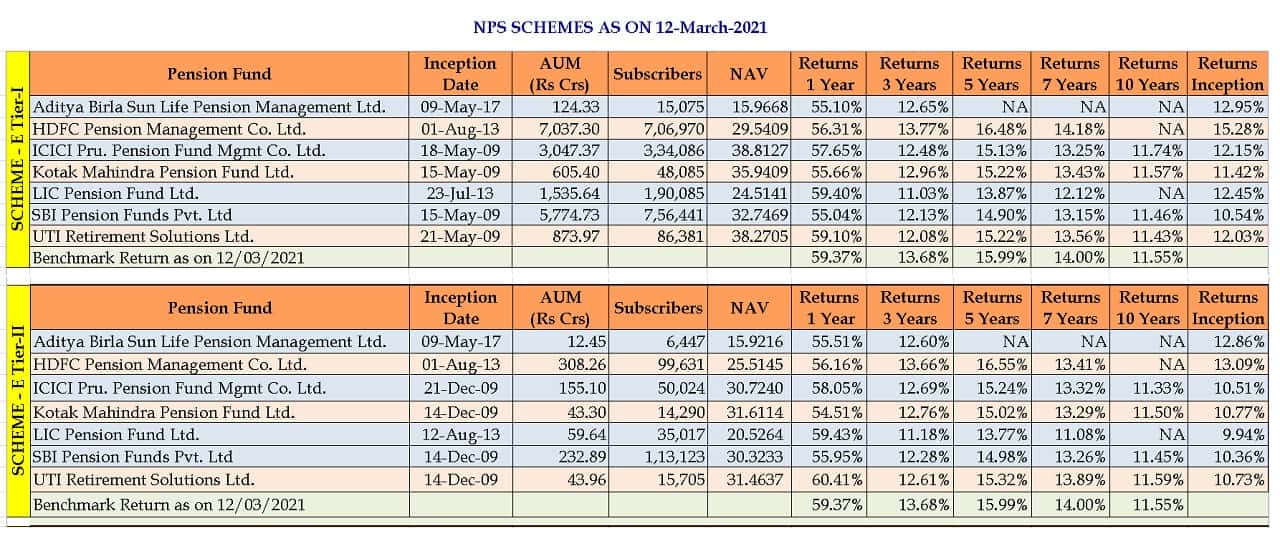Last Updated on October 1, 2023 at 5:40 pm
This is a question that we have received several times in the last few months: Since NPS (National pension scheme) is a low-cost product, can we use it as an index fund. Typically people wish to use Tier II this way since it has no lock-in. A discussion.
First, the basics. NPS Tier I and Tier II are low-cost mutual funds, but they are NOT passive funds or index funds! Go to any NPS PFM site (pension fund manager). Under “public disclosures”, look for “policies” or “investment policies”.
This, for example, is the objective stated by SBI Pension Fund
generating the best available returns for the subscribers over the long term while ensuring the safety and security of such investments. Keeping in view the fact that returns are market related, it is proposed to strive for yield maximization within the investment pattern approved by PFRDA and chosen by the subscribers
No “passive” investment would aim for this. Also, come to think of it, it is not safe for NPS to be a passive investment, nor is it practical. Sensex or Nifty or even NIfty 100 could have a few stocks with more than 10% weight. This could mean a huge chunk of AUM concentrated in a few stocks. NPS portfolios do have a few concentrated bets, but as its AUM grows, that decreases. The extreme example is the government NPS portfolio with each security weight not more than a few per cent.
Join 32,000+ readers and get free money management solutions delivered to your inbox! Subscribe to get posts via email! (Link takes you to our email sign-up form)
🔥Want to create a complete financial plan? Learn goal-based investing? Exclusive access to our DIY tools? Increase your income with your skills? Enjoy massive discounts on our robo-advisory tool & courses! 🔥
Also, one cannot hold a Tier II account without a Tier I account. If NPS is mandatory for you or is provided as an option by the employer with employer contributions, then and only then does it make sense to discuss Tier II. Because NPS itself does not make sense otherwise.
The key reason for our vehement objection to NPS is liquidity (the ability to redeem when we want and how much ever we want). Most investors fail to appreciate this because they have a spreadsheet-like vision of the future: “If I invest Rs X every month and it grows at the rate of Y per cent, how much will I get after Z years”. It is fun to play this game in a spreadsheet, but there can be a hundred reasons why we would need the money before the Z years are complete in real life.
NPS has an atrocious exit clause. Exit at age 60 or after, you can get back 60% of your corpus tax-free – this is quite fine. Exit one year earlier, and you lose 40% of that corpus to an annuity.
All sorts of arguments were invented by investors who only invested in NPS because of the “extra 50K tax-saving”: “but a retirement product should have a lock-in”, “investor should use other investment for liquidity”, etc. The logic is similar to an emergency fund: those who have never witnessed an emergency try to find out the “best way to invest the emergency fund”. Similarly, those who have never seen a liquidity crunch assume it is not necessary.
So when Tier I does not make sense (unless you have a stable job and get tax-deductible contributions from an employer), there is no point discussing Tier II. Leaving alone this talk of liquidity which few would appreciate, let us look at scheme returns.
The NPS trust publishes weekly returns, and some portals like Value Research or ET provide daily updates. In Sep 2019, we published a detailed study of NPS Tier 1 Equity Scheme Performance vs Nifty 50 and Nifty 100 and showed that established NPS PFMs have underperformed the Nifty 100.
Some reactions to this were amusing: “but look at HDFC PFM. They have got better returns”. If you look at returns as of March 12th 2021, HDFC beat the index over 3/5/7 years underperformed the index by almost 3% in the last year like a typical active fund. Also, the spread in returns across PFMS is high again, typical of active funds.

To say the least, the investment strategy of these funds (assuming there is one) is vague. It makes no sense to invest in NPS Tier II (or Tier I) just because the TER (0.01% PFM fee + 0.005% NPS trust fee + 0.0032% custodian fee + POP fee on investment) is “low”.
Even if a Sensex/Nifty index fund (0.1%) fee is about 1.7 times higher than the typical Tier I or Tier II equity scheme, the mandate is clear. NPS funds may be “low cost”; they are also “low” on active management, too, with many of them not doing more than following the index or even underperforming it. This is unacceptable when the mandate is to “maximise gains/yield”. There is more to investing than “low fees”.
Then there is the factor of taxation. No one knows how Tier II is to be taxed. That is, there is no official documentation on it. This means until there is such documentation, you have to report these as “income from other sources” and tax them as per slab!
- If you invest in corporate or individual NPS, we recommend that you use a mix of G (govt bonds) and C (corporate bonds) schemes in Tier I and avoid Tier II.
- If you invest in govt NPS, we recommend you stick to the default allocation: 15% of Equity and the bulk of the remaining in G.
- If you are considering NPS for saving tax, we recommend that you stay away. If you cannot sleep in peace without getting that “50K benefit”, at least ensure you invest enough elsewhere!
🔥Enjoy massive discounts on our courses, robo-advisory tool and exclusive investor circle! 🔥& join our community of 7000+ users!
Use our Robo-advisory Tool for a start-to-finish financial plan! ⇐ More than 2,500 investors and advisors use this!
Track your mutual funds and stock investments with this Google Sheet!
We also publish monthly equity mutual funds, debt and hybrid mutual funds, index funds and ETF screeners and momentum, low-volatility stock screeners.





- Do you have a comment about the above article? Reach out to us on Twitter: @freefincal or @pattufreefincal
- Have a question? Subscribe to our newsletter using the form below.
- Hit 'reply' to any email from us! We do not offer personalized investment advice. We can write a detailed article without mentioning your name if you have a generic question.
Join 32,000+ readers and get free money management solutions delivered to your inbox! Subscribe to get posts via email! (Link takes you to our email sign-up form)
About The Author
 Dr M. Pattabiraman(PhD) is the founder, managing editor and primary author of freefincal. He is an associate professor at the Indian Institute of Technology, Madras. He has over ten years of experience publishing news analysis, research and financial product development. Connect with him via Twitter(X), Linkedin, or YouTube. Pattabiraman has co-authored three print books: (1) You can be rich too with goal-based investing (CNBC TV18) for DIY investors. (2) Gamechanger for young earners. (3) Chinchu Gets a Superpower! for kids. He has also written seven other free e-books on various money management topics. He is a patron and co-founder of “Fee-only India,” an organisation promoting unbiased, commission-free investment advice.
Dr M. Pattabiraman(PhD) is the founder, managing editor and primary author of freefincal. He is an associate professor at the Indian Institute of Technology, Madras. He has over ten years of experience publishing news analysis, research and financial product development. Connect with him via Twitter(X), Linkedin, or YouTube. Pattabiraman has co-authored three print books: (1) You can be rich too with goal-based investing (CNBC TV18) for DIY investors. (2) Gamechanger for young earners. (3) Chinchu Gets a Superpower! for kids. He has also written seven other free e-books on various money management topics. He is a patron and co-founder of “Fee-only India,” an organisation promoting unbiased, commission-free investment advice.Our flagship course! Learn to manage your portfolio like a pro to achieve your goals regardless of market conditions! ⇐ More than 3,000 investors and advisors are part of our exclusive community! Get clarity on how to plan for your goals and achieve the necessary corpus no matter the market condition is!! Watch the first lecture for free! One-time payment! No recurring fees! Life-long access to videos! Reduce fear, uncertainty and doubt while investing! Learn how to plan for your goals before and after retirement with confidence.
Our new course! Increase your income by getting people to pay for your skills! ⇐ More than 700 salaried employees, entrepreneurs and financial advisors are part of our exclusive community! Learn how to get people to pay for your skills! Whether you are a professional or small business owner who wants more clients via online visibility or a salaried person wanting a side income or passive income, we will show you how to achieve this by showcasing your skills and building a community that trusts and pays you! (watch 1st lecture for free). One-time payment! No recurring fees! Life-long access to videos!
Our new book for kids: “Chinchu Gets a Superpower!” is now available!


Must-read book even for adults! This is something that every parent should teach their kids right from their young age. The importance of money management and decision making based on their wants and needs. Very nicely written in simple terms. - Arun.Buy the book: Chinchu gets a superpower for your child!
How to profit from content writing: Our new ebook is for those interested in getting side income via content writing. It is available at a 50% discount for Rs. 500 only!
Do you want to check if the market is overvalued or undervalued? Use our market valuation tool (it will work with any index!), or get the Tactical Buy/Sell timing tool!
We publish monthly mutual fund screeners and momentum, low-volatility stock screeners.
About freefincal & its content policy. Freefincal is a News Media Organization dedicated to providing original analysis, reports, reviews and insights on mutual funds, stocks, investing, retirement and personal finance developments. We do so without conflict of interest and bias. Follow us on Google News. Freefincal serves more than three million readers a year (5 million page views) with articles based only on factual information and detailed analysis by its authors. All statements made will be verified with credible and knowledgeable sources before publication. Freefincal does not publish paid articles, promotions, PR, satire or opinions without data. All opinions will be inferences backed by verifiable, reproducible evidence/data. Contact information: To get in touch, use this contact form. (Sponsored posts or paid collaborations will not be entertained.)
Connect with us on social media
- Twitter @freefincal
- Subscribe to our YouTube Videos
- Posts feed via Feedburner.
Our publications
You Can Be Rich Too with Goal-Based Investing
 Published by CNBC TV18, this book is meant to help you ask the right questions and seek the correct answers, and since it comes with nine online calculators, you can also create custom solutions for your lifestyle! Get it now.
Published by CNBC TV18, this book is meant to help you ask the right questions and seek the correct answers, and since it comes with nine online calculators, you can also create custom solutions for your lifestyle! Get it now.Gamechanger: Forget Startups, Join Corporate & Still Live the Rich Life You Want
 This book is meant for young earners to get their basics right from day one! It will also help you travel to exotic places at a low cost! Get it or gift it to a young earner.
This book is meant for young earners to get their basics right from day one! It will also help you travel to exotic places at a low cost! Get it or gift it to a young earner.Your Ultimate Guide to Travel
 This is an in-depth dive into vacation planning, finding cheap flights, budget accommodation, what to do when travelling, and how travelling slowly is better financially and psychologically, with links to the web pages and hand-holding at every step. Get the pdf for Rs 300 (instant download)
This is an in-depth dive into vacation planning, finding cheap flights, budget accommodation, what to do when travelling, and how travelling slowly is better financially and psychologically, with links to the web pages and hand-holding at every step. Get the pdf for Rs 300 (instant download)